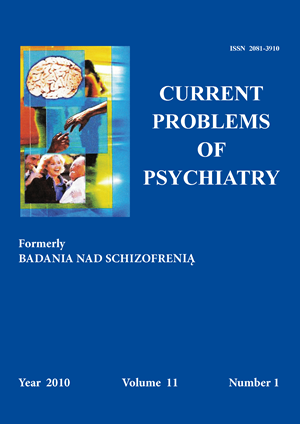Urojenia - zaburzenia treści myślenia
Słowa kluczowe:
delusions, psychopathologyAbstrakt
Delusions typically occur in the context of neurological or mental illness, although they are not tied to any particular disease. However, they are of particular diagnostic importance in psychotic disorder and particularly in schizophrenia, paraphrenia, manic episodes of bipolar disorder, and psychotic depression. The psychiatrist Karl Jaspers was the first to define the three main criteria of delusion - certainty (held with absolute conviction), incorrigibility (not changeable by compelling counterargument or proof to the contrary), impossibility or falsity of content (implausible, bizarre or patently untrue). DSM defines delusion as a false belief based on incorrect inference about external reality that is firmly sustained despite what almost everybody else believes and despite what constitutes incontrovertible and obvious proof or evidence to the contrary. Delusions are often sole symptoms of mental disorders. They have significant role in psychopathology thus understanding the patients with this kind of symptoms plays important role in cure and medical treatment. The paper describes changes in psychopathologies concept and definition of delusion. Different types of delusions (delusions of control, nihilistic delusions, delusions of infidelity, delusions of guilt or sin, delusions of mind being read, delusions of reference, grandiose delusions, persecutory delusions, religious delusions) with their clinical examples are presented.
Bibliografia
1. Jaspers K. General Psychopathology, 7th ed(1923), Manchester; Manchester University Press: 1962.
2. Bell V., Halligan P.W., Ellis H.D. Explaining delusions: a cognitive perspective. TRENDS in cognitive Sciences, 2006; 10(5): 219-226.
3. Nasar S. Piękny umysł. Warszawa; Wydawnictwo Albatros Andrzej Kuryłowicz, Warszawskie Wydawnictwo Muza: 2002.
4. Jorgensen P., Aagard J. A multivariate predictor analysis of course and outcome in delusional psychosis. Acta Psychiatr. Scand., 1988; 77: 543-550.
5. Lysaker P.H., Lancaster R.S., Nees M.A., Davis L.W. Neuroticism and visual memory impairments as predictors of the severity of delusions in schizophrenia. Psychiatry Research, 2003; 119: 287-292.
6. Coltheart M., Langdon R., McKay R. Schizophrenia and monothematic delusions. Schizophrenia Bull., 2007; 1-6.
7. Strauss J. S. Hallucinations and delusions as points on continua function. Arch. Gen. Psychiatr., 1969; 21(5): 581-586.
8. Combs D.R., Adams S.D., Michael C.O., Penn D.L., Basso M.R., Gouvier W.D. The conviction of delusional beliefs scale: Reliability and validity. Schizophrenia Res., 2006; 86: 80-88.
9. Simpson J., Done D.J. Elasticity and confabulation in schizophrenic delusions. Psychol. Med., 2002; 32: 451-458.
10. Marsella A.J. Cross-cultural research on sever mental disorders: issues and findings. Acta Psychiat. Scand., 1988; 78, suppl. 344: 7-22.
11. Goff D.C., Brotman A.W., Kindlon D., Waites M., Amico E. The delusion of possession in chronically psychotic patients. The Journal of Nervous and Mental Disease, 1991; 179(9): 567-571.
12. Garlipp P., Godecke –Koch T., Dietrich D.E., Haltenhof H. Lykantropy-psychopathological and psychodynamical aspects. Acta Psychiatr. Scand., 2004; 109: 19-22.
13. Incorvaia D., Helmes E. Shared psychotic disorder: A psychosocial psychosis? Current Psychiatry Rev., 2006; 2: 353-360.
14. Chlewiński Z.,Grzywa A. Urojeniowa wizja świata. Wiedza Powszechna: 1992.


